Related Research Articles

Ubbe Ert Iwerks, known as Ub Iwerks, was an American animator, cartoonist, character designer, inventor, and special effects technician, known for his work with Walt Disney Animation Studios in general, and for having worked on the development of the design of the character of Mickey Mouse, among others. Born in Kansas City, Missouri, Iwerks grew up with a contentious relationship with his father, who abandoned him as a child. Iwerks met fellow artist Walt Disney while working at a Kansas City art studio in 1919.

Plane Crazy is a 1929 American animated short film directed by Walt Disney and Ub Iwerks. The cartoon, released by the Walt Disney Studios, is the first finished project to feature appearances of Mickey Mouse and Minnie Mouse, and was originally a silent film. It was given a test screening to a theater audience and potential distributors on May 15, 1928. An executive from Metro-Goldwyn-Mayer saw the film, but the film failed to pick up a distributor. Later that year, Disney released Mickey's first sound cartoon, Steamboat Willie, which was an enormous success; Plane Crazy was officially released as a sound cartoon on March 17, 1929. It was the fourth Mickey film to be given a wide release after Steamboat Willie, The Gallopin' Gaucho and The Barn Dance (1929).
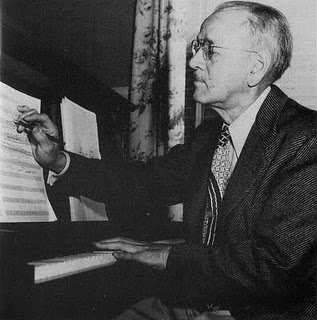
Carl William Stalling was an American composer, voice actor and arranger for music in animated films. He is most closely associated with the Looney Tunes and Merrie Melodies shorts produced by Warner Bros., where he averaged one complete score each week, for 22 years.

The golden age of American animation was a period that began with the popularization of sound synchronized cartoons in 1928 and gradually ended in the 1960s when theatrical animated shorts started to lose popularity to the newer medium of television. Animated media from after the golden age, especially on television, were produced on cheaper budgets and with more limited techniques between the late 1950s and 1980s.
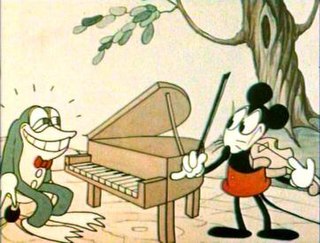
Flip the Frog is an animated cartoon character created by American animator Ub Iwerks. He starred in a series of cartoons produced by Celebrity Pictures and distributed by Metro-Goldwyn-Mayer from 1930 to 1933. The series had many recurring characters, including Flip's dog, the mule Orace, and a dizzy neighborhood spinster.
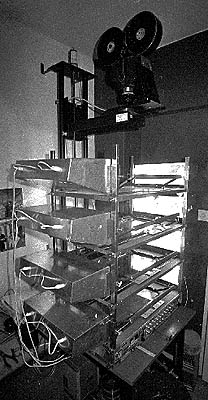
The multiplane camera is a motion-picture camera that was used in the traditional animation process that moves a number of pieces of artwork past the camera at various speeds and at various distances from one another. This creates a sense of parallax or depth.
ComiColor Cartoons is a series of twenty-five animated short subjects produced by Ub Iwerks from 1933 to 1936. The series was the last produced by Iwerks Studio; after losing distributor Metro-Goldwyn-Mayer in 1934, the Iwerks studio's senior company Celebrity Pictures had to distribute the films itself. The series was shot exclusively in Cinecolor.

Patrick Anthony Powers was an American producer who was involved in the movie and animation industry from the 1910s to 1930s. He established Powers' Cinephone Moving Picture Company, also known as Powers Picture Plays. His firm, Celebrity Productions, was the first distributor of Walt Disney's Mickey Mouse cartoons (1928–1929). After one year, Disney split with Powers, who started the animation studio Iwerks Studio with Disney's lead animator, Ub Iwerks.
Willie Whopper is an animated cartoon character created by American animator Ub Iwerks. The Whopper series was the second from the Iwerks Studio to be produced by Pat Powers and distributed through Metro-Goldwyn-Mayer. 14 shorts were produced in 1933 to 1934.

Myron "Grim" Natwick was an American artist, animator, and film director. Natwick is best known for drawing the Fleischer Studios' most popular character, Betty Boop.
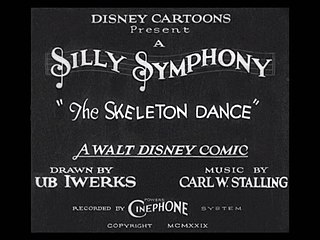
The Skeleton Dance is a 1929 Silly Symphony animated short subject with a comedy horror theme. It was produced and directed by Walt Disney and animated by Ub Iwerks. In the film, four human skeletons dance and make music around a spooky graveyard—a modern film example of medieval European "danse macabre" imagery. It is the first entry in the Silly Symphony series. In 1993, to coincide with the opening of Mickey's Toontown in Disneyland, a shortened cover of the cartoon's music was arranged to be featured in the land's background ambiance. The short's copyright was renewed in 1957, and as a published work from 1929 it will enter the US public domain on January 1, 2025.

The Metro-Goldwyn-Mayer cartoon studio was an American animation studio operated by Metro-Goldwyn-Mayer during the Golden Age of American animation. Active from 1937 until 1957, the studio was responsible for producing animated shorts to accompany MGM feature films in Loew's Theaters, which included popular cartoon characters Tom, Jerry, Droopy, Butch, Spike, Tyke, and Barney Bear.

Rainbow Parade is a series of 26 animated shorts produced by Van Beuren Studios and distributed to theaters by RKO between 1934 and 1936. This was the only color cartoon series produced by Van Beuren, and the final series of the studio.
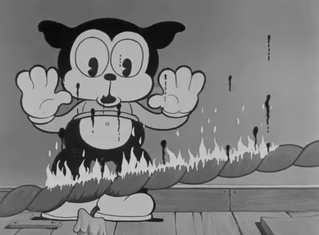
Bimbo's Initiation is a 1931 Fleischer Studios Talkartoon animated short film starring Bimbo and featuring an early version of Betty Boop with a dog's ears and nose. It was the final Betty Boop cartoon to be animated by the character's co-creator, Grim Natwick, prior to his departure for Ub Iwerks' studio.
Fiddlesticks is a 1930 Celebrity Pictures theatrical cartoon short directed and animated by Ub Iwerks, in his first cartoon since he departed from Walt Disney's studio. The short features Iwerks' character Flip the Frog. It is the first complete sound cartoon to be photographed in color.
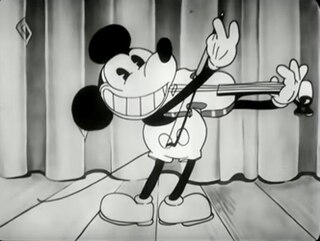
Fiddlin’ Around is a 1930 animated short film produced by Walt Disney Productions and released by Columbia Pictures as part of the Mickey Mouse film series. It was the sixteenth Mickey Mouse short to be produced, the first of that year.
Isadore Howard Ellis was an American animator best known for working for Warner Bros. Cartoons under the Bob Clampett and Frank Tashlin units. He was credited as I. Ellis.
Iwerks Studio was an animation studio headed by animator Ub Iwerks.
This is a list of short films created by Walt Disney Animation Studios between the years 1928 and 1939.
References
- ↑ Vide the leaflet included with Thunderbean Animation's Blu-ray Ub Iwerks' Willie Whopper
- ↑ Maltin, Leonard. Of Mice and Magic: a History of American Animated Cartoons. Von Hoffmann Press, Inc., 1980. p. 189.
- ↑ Salda, Michael N. (July 30, 2013). Arthurian Animation: A Study of Cartoon Camelots on Film and Television. McFarland. ISBN 978-1-4766-0614-9.
- ↑ Grant, John (2001). Masters of Animation. Batsford. ISBN 978-0-7134-8554-7.
- ↑ Maltin, Leonard. Of Mice and Magic: a History of American Animated Cartoons. Von Hoffmann Press, Inc., 1980. p. 392.
- ↑ Webb, Graham (2000). The Animated Film Encyclopedia: A Complete Guide to American Shorts, Features and Sequences 1900–1979. McFarland. ISBN 978-0-7864-0728-6.
- ↑ For her name, vide Willie Whopper on Don Markstein's Toonopedia
- ↑ Stanchfield, Steve. Willie Whopper in "The Good Scout" (1934). Cartoon Research. Accessed Dec. 31, 2023.